Both of my parents were born in Leskovac, south Serbia. My father's parents belonged to old, native families, while my mother's family had “settled” there during their movement through central and southern Serbia, including (Northern) Macedonia. On the other hand, my father moved to Belgrade with his mother and younger sisters even before World War II, while later, my mother and father met in Belgrade and got married there. That eventually led to the birth of my brother and then me.
As children, my brother and I regularly spent every school holiday in Leskovac with our grandmother and aunt (our mother's mother and sister). We would also each time visit our father's side of the family. Besides going on excursions around Leskovac, it was normal for us to walk between our grandmother’s flat and our aunt’s house, so I would often pass by certain buildings that I only much later realised were important to our national culture.
In the summer of 2025, I decided to go to Leskovac, but with a clear intention to start visiting cultural monuments in the city and surrounding areas. At first, I concluded I would need at least 10 days for everything I had planned, but I also realised that for various reasons I couldn’t set aside that much time, so I went for 4–5 days instead.
In the meantime, things had significantly changed within the family, both my grandmother and my aunt are no longer alive, but my cousin (my aunt’s daughter) is still there, so I stayed with her. Also, it was fortunate that my other cousin (my aunt’s son) hadn’t left for his vacation yet, so I saw him briefly as well. I had also planned to see another cousin and her daughter (on my father’s side). In the case of this other cousin, we share great-grandparents, in other words, our parents were first cousins, but among traditionally oriented Serbs, that’s not an issue – we’re still considered sisters. (Just a side note – in Serbian culture we have a very complex system of names for different relations, which, among other things, means that we call all cousins “sisters” or “brothers” depending on the gender, but with addition of “from aunt” or “from uncle”. There are three different words each for “aunt” and “uncle,” respectively, depending on the exact link to the parents.)
Here are the places and cultural monuments I visited during this short stay in Leskovac and the surrounding area:
Leskovac is one of the larger cities in Serbia, the sixth largest (excluding Priština), and is located in the southern part of the country.
The first traces of life in this area of the present-day Serbia date back to around 6200 BCE. Various archaeological excavations conducted in several places around Leskovac confirm this, while the most important archaeological site near the city is Caričin Grad or Iustiniana Prima, dating from the 6th century CE. I’ve already visited it a couple of times before, though not during this trip, so I’ll leave the story of that site for another time, just noting that it is exceptionally important.
Around the time of Iustiniana Prima, the Slavs also began settling in this region (6th–7th century).
In the 12th century, the then-settlement of Dubočica (the old name for Leskovac) became part of the Raška (Serbian) state, ruled by the Grand Prince Stefan Nemanja (born around 1113/1114–1199, ruled 1166–1196). Over the following centuries, Dubočica remained part of the Serbian territories, but from 1454 until 1877 it was under the Ottoman rule, like much of the present-day Serbia.
The new name of the settlement, Leskovac, began appearing in the Ottoman records during the 16th century. It is believed that the name originated from the abundance of hazel forests (leska is the name for a hazel tree) that once grew in the area.
After the liberation from the Turks, Leskovac continued to develop as an important craft centre, while up until World War II, the textile industry was especially prominent here and it remained dominant even after the war. This was so notable that Leskovac was once nicknamed the “Serbian Manchester,” after the English city that was world-renowned as a textile industry hub.
In the early 1990s, the Socialist Federal Republic of Yugoslavia began to disintegrate, wars broke out, and economic sanctions and hyperinflation followed. All of this, as in the rest of the country, led to general stagnation.
Unfortunately, Leskovac shared the fate of the rest of Serbia when it came to heavy destruction – the Germans bombed it at the beginning of World War II (1941) and the Allies bombed it towards the end (1944). The city and its surroundings also suffered damage during the NATO bombings in 1999.
When I returned from this trip to Leskovac, I met up with a friend who asked me about my impressions. She mentioned that she had never been there, but had heard from several people that Leskovac is an “ugly city.” I replied that it is like most other Serbian cities (with few exceptions) – a mix of various old houses designed according to different principles and styles (if the word style can even be applied to some of them), although there are also new houses and buildings, while important factors also include the manner of their construction and how long such buildings tend to last, frequent destruction from bombings and wars, the absence of focused and intentional care both individual and institutional, our well-known neglect, inherited urban planning patterns (there is a noticeable difference in the country between the Austro-Hungarian influences in the north and the Ottoman influences in the centre and south), complete shifts in social systems, decades of economic hardships, and so on.
I'm not sure if I gave a good answer. Leskovac is certainly not a "beautiful" city in the classical sense of meaning, but I can still find beauty in it, because, as the saying goes, "Beauty is in the eye of the beholder." I can also say that I love this city. I love my emotional connection to it, I love the memories of a wonderful and carefree childhood, I love my family who lives there, I love coming back to it, and I love various other details that I’ll mention or weave into these “travel stories” of mine. Besides, it's a city in my country and it’s a part of my people, culture, and history – with all its good and bad sides. Isn't that enough?
On the other hand, while writing these stories, I came across a quote by Marcel Proust: “The real voyage of discovery is not in seeking new landscapes, but in having new eyes.”
That’s exactly what my stories will show – on one level, there are my memories of the past, and on another, they are my impressions of cultural monuments in the present moment, as I see and experience them. But there's also an awareness of various details and small things that we may tend to overlook or take for granted, while giving disproportionate and unrealistic importance to others.
I plan to return to the question of the city's “beauty” later on. For now, I’ll begin with the story and photos of the cultural monuments I saw or visited here.
It makes perfect sense to start with the Cathedral of the Holy Trinity, located in the very centre of the city. The main reason is that this is the church where I was baptised. My parents weren’t particularly religious – my father was an atheist, while my mother deeply respected and observed all the major church holidays (Christmas, Easter, Slava – the family patron saint’s day, etc.). She also taught me how to enter and exit a church, how to cross myself, and so on, but she wasn’t a devoted believer nor did she take the initiative when it came to the baptising of my brother and me. That’s why our grandmother stepped in and took matters into her own hands, so both my brother and I were baptised here in the mid-1970s. I mention the year only for those who claim that such things were forbidden during socialism.
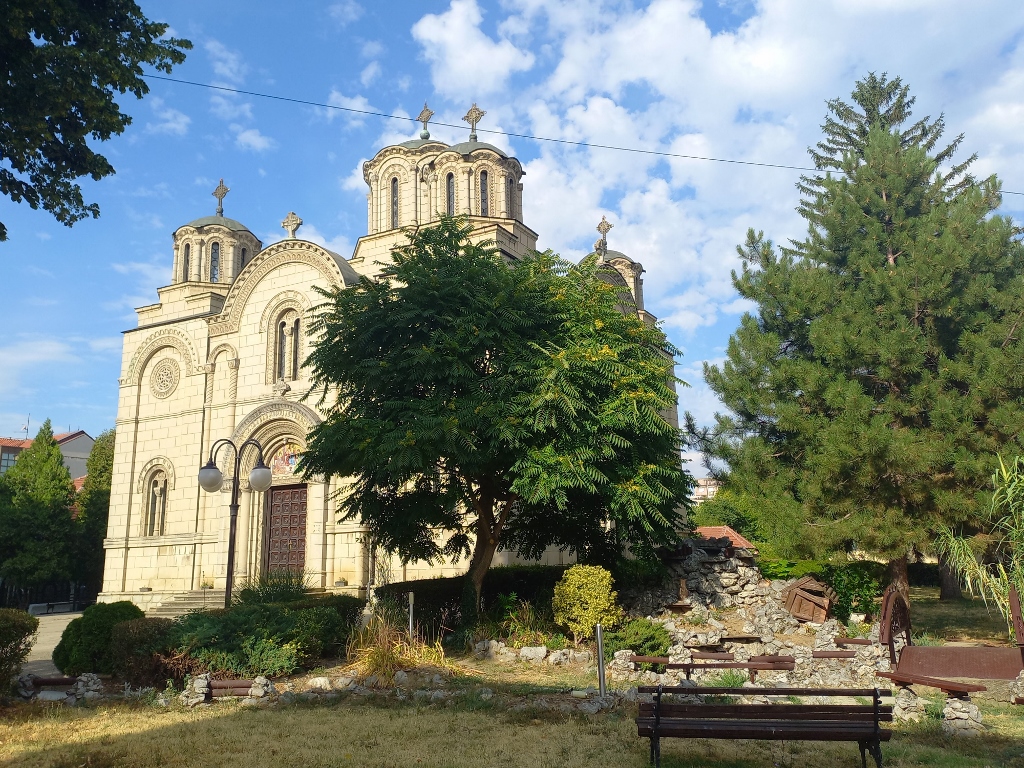 Cathedral of the Holy Trinity in Leskovac
Cathedral of the Holy Trinity in Leskovac
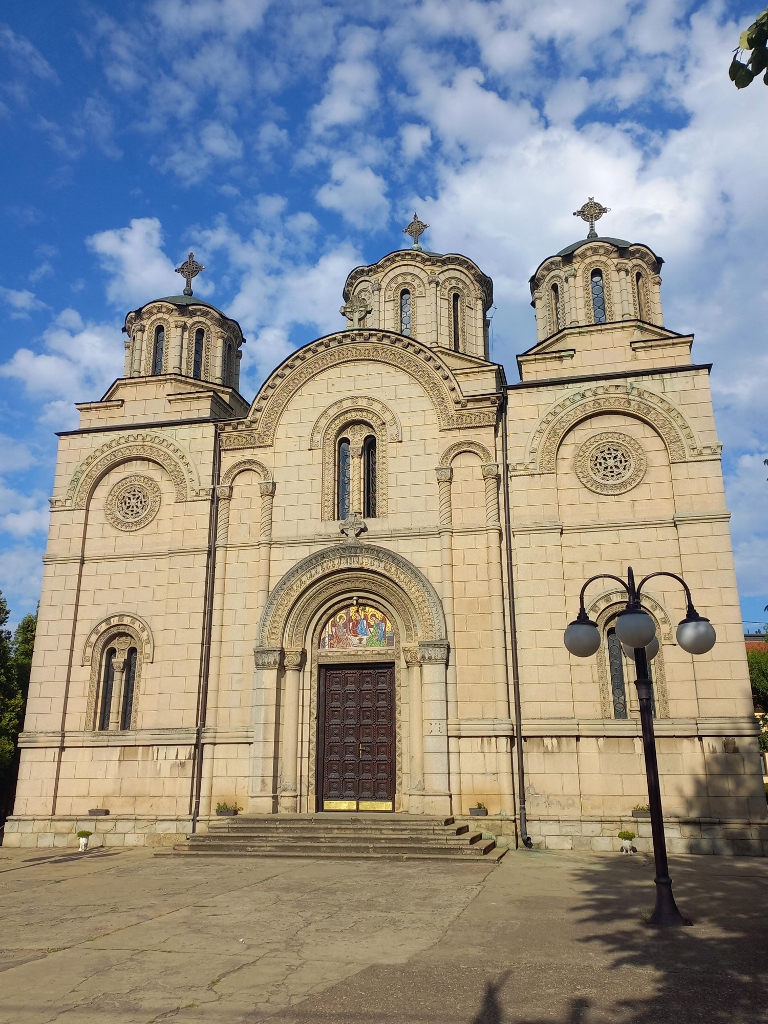 Cathedral of the Holy Trinity
Cathedral of the Holy Trinity
The construction of the Cathedral of the Holy Trinity began after World War I, but it progressed rather slowly and with several interruptions, primarily due to financial difficulties and a lack of funds. The church was finally completed and consecrated in 1931.
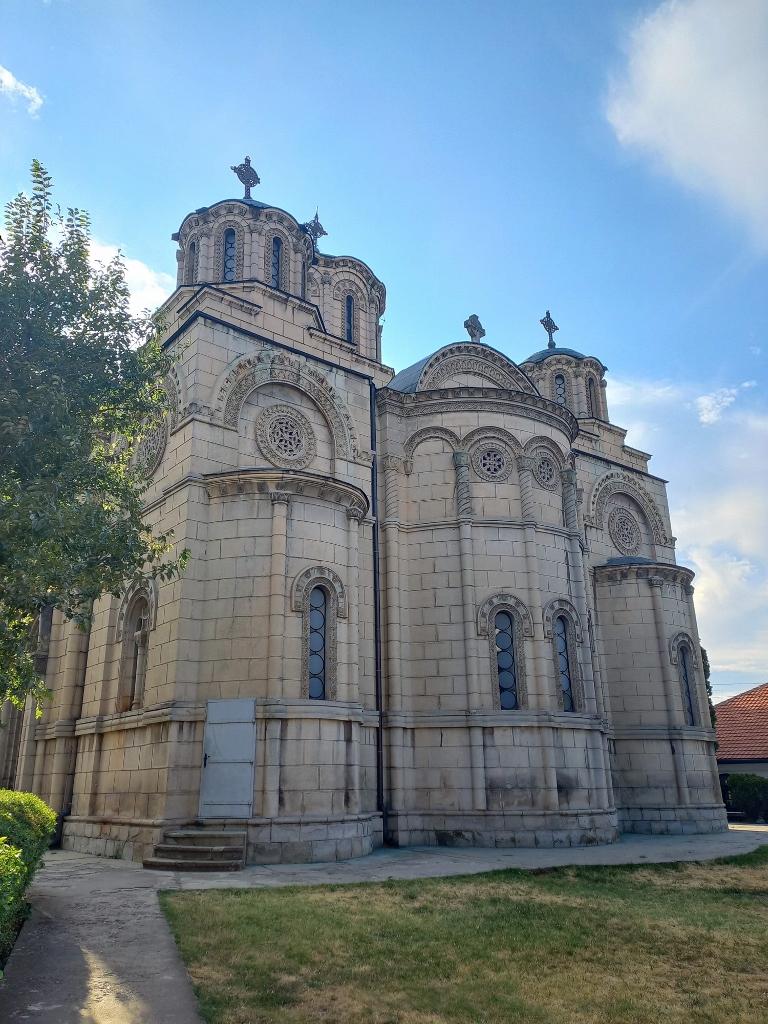 Cathedral of the Holy Trinity
Cathedral of the Holy Trinity
Due to its design featuring a large central dome above the nave and four smaller domes at the corners, as well as elements of the exterior decoration, the church resembles medieval Serbian churches, combining both Serbian-Byzantine and Moravan architectural elements.
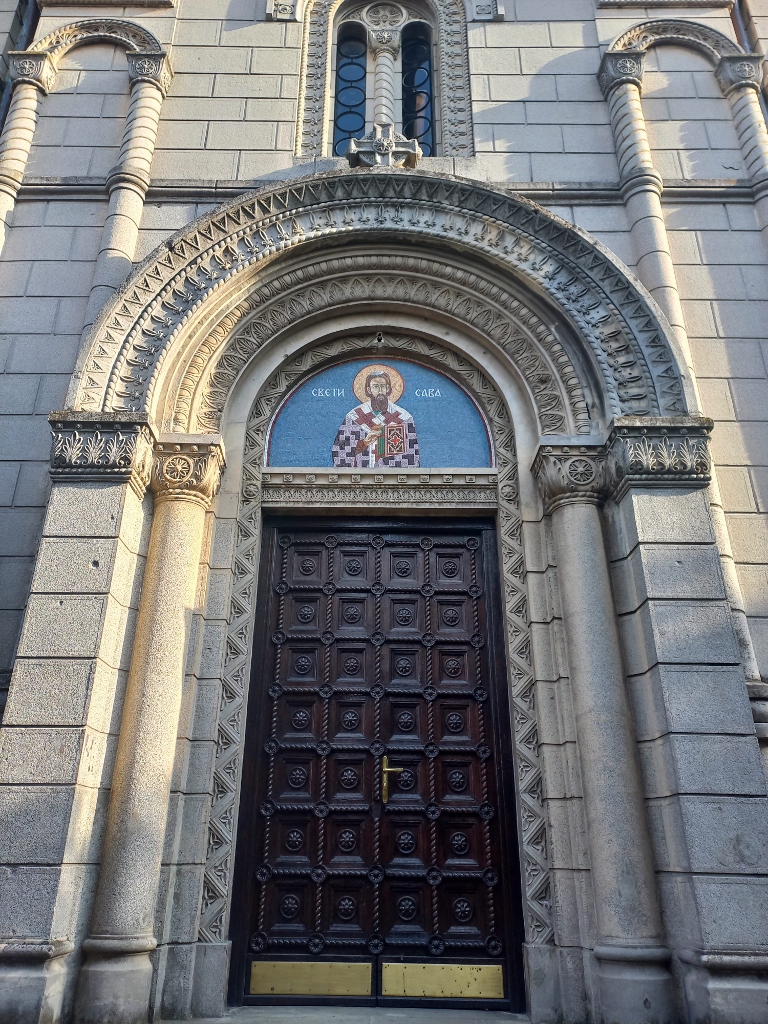 Cathedral of the Holy Trinity, a detail
Cathedral of the Holy Trinity, a detail
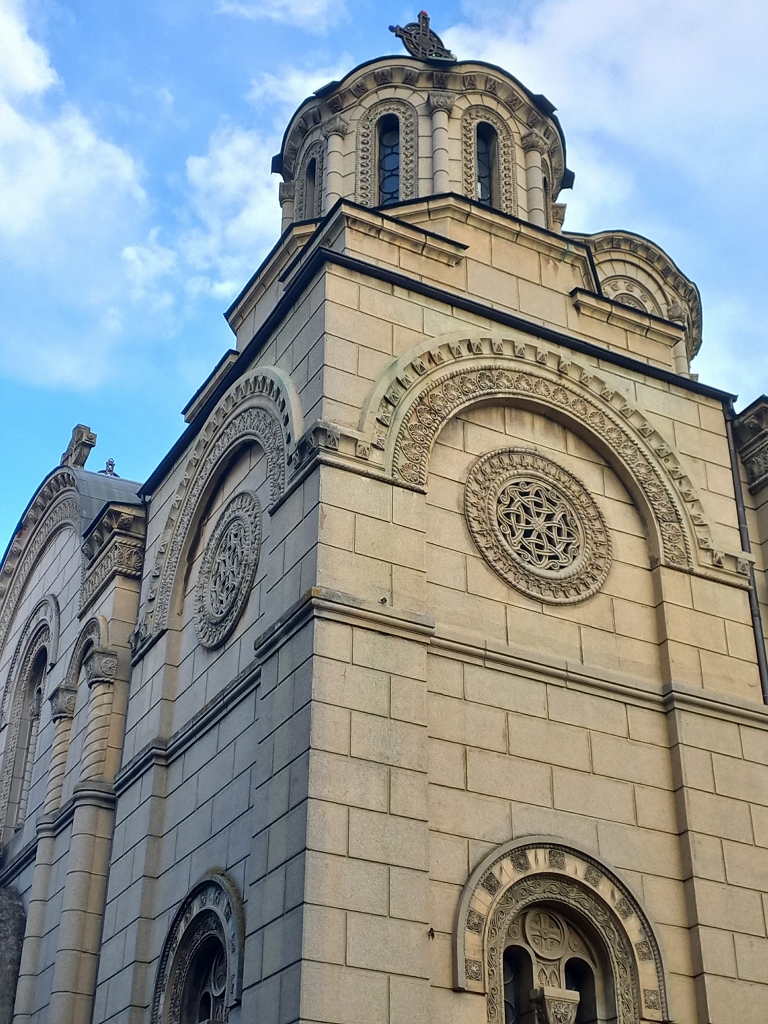 Cathedral of the Holy Trinity, a detail
Cathedral of the Holy Trinity, a detail
By the time I walked around the church and examined various details, the time for the evening liturgy approached and the door was wide open.
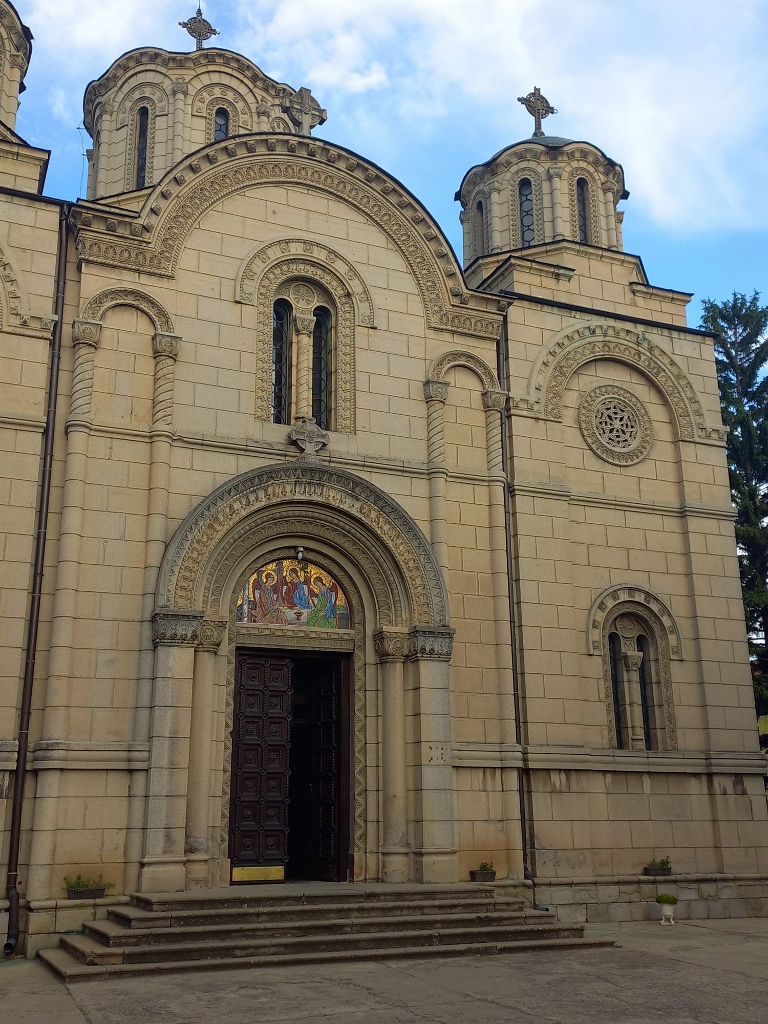 Cathedral of the Holy Trinity, a detail
Cathedral of the Holy Trinity, a detail
I went inside and quickly glanced around the interior before the service began.
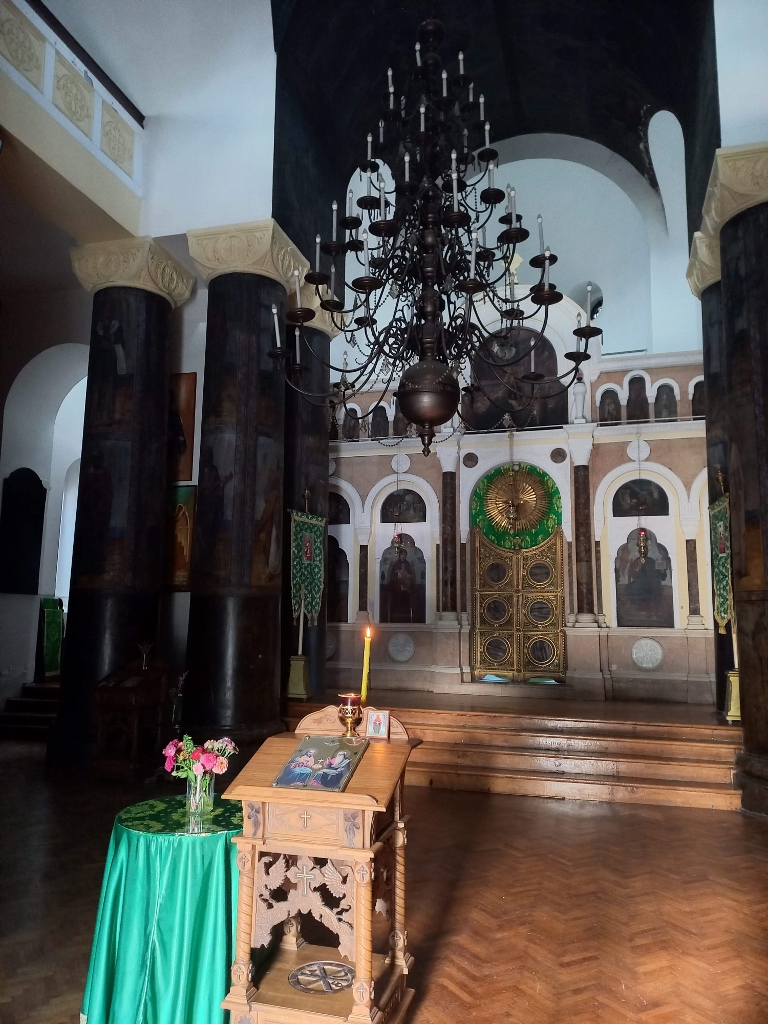 Cathedral of the Holy Trinity, a detail
Cathedral of the Holy Trinity, a detail
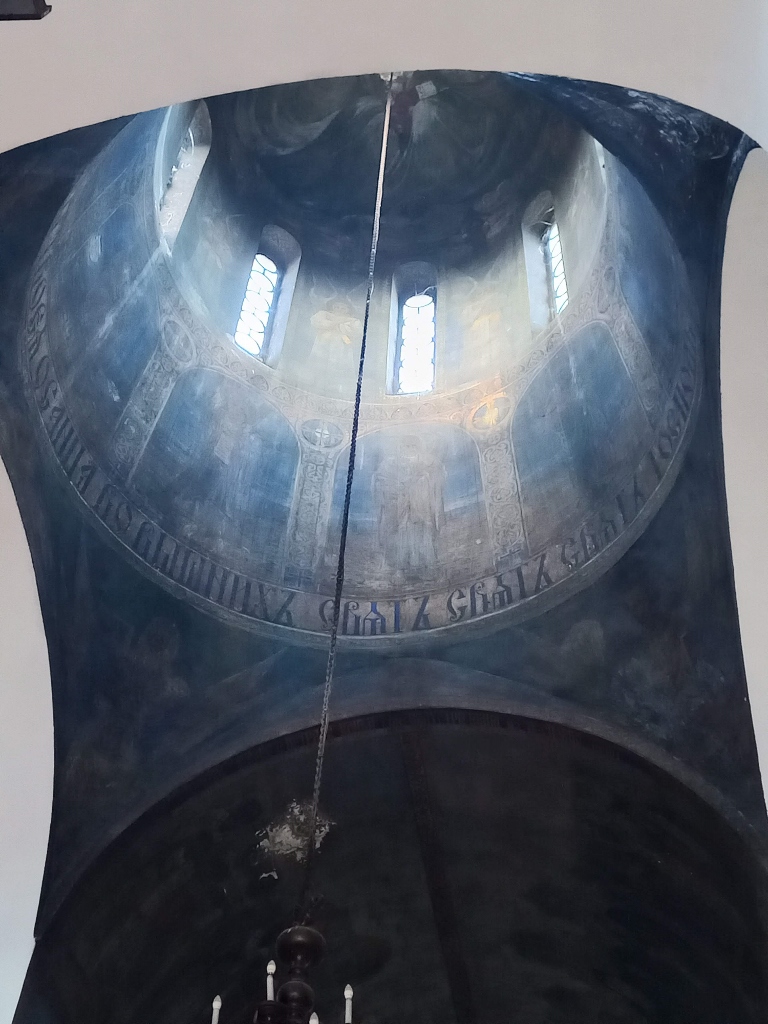 Cathedral of the Holy Trinity, a detail
Cathedral of the Holy Trinity, a detail
Parts of southern Serbia, including Leskovac, were under Bulgarian occupation during World War I (as well as in World War II), and inside the church there are plaques that testify to the fact that from 1915 to 1917 the Bulgarians killed around a dozen priests, as well as several prominent citizens of the city. The church also contains the graves of the church’s greatest benefactors, the married couple Petar and Jelena Ilić. He was a well-known industrialist in the early 20th century, when his textile factory was one of the largest in the Balkans.
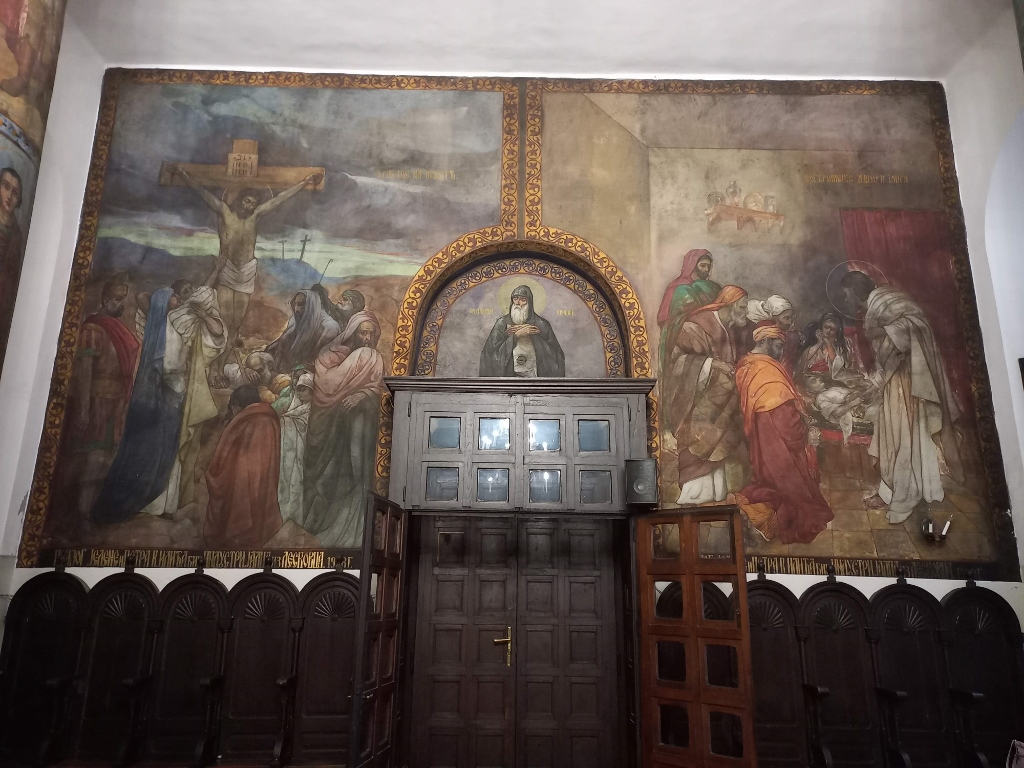 Cathedral of the Holy Trinity
Cathedral of the Holy Trinity
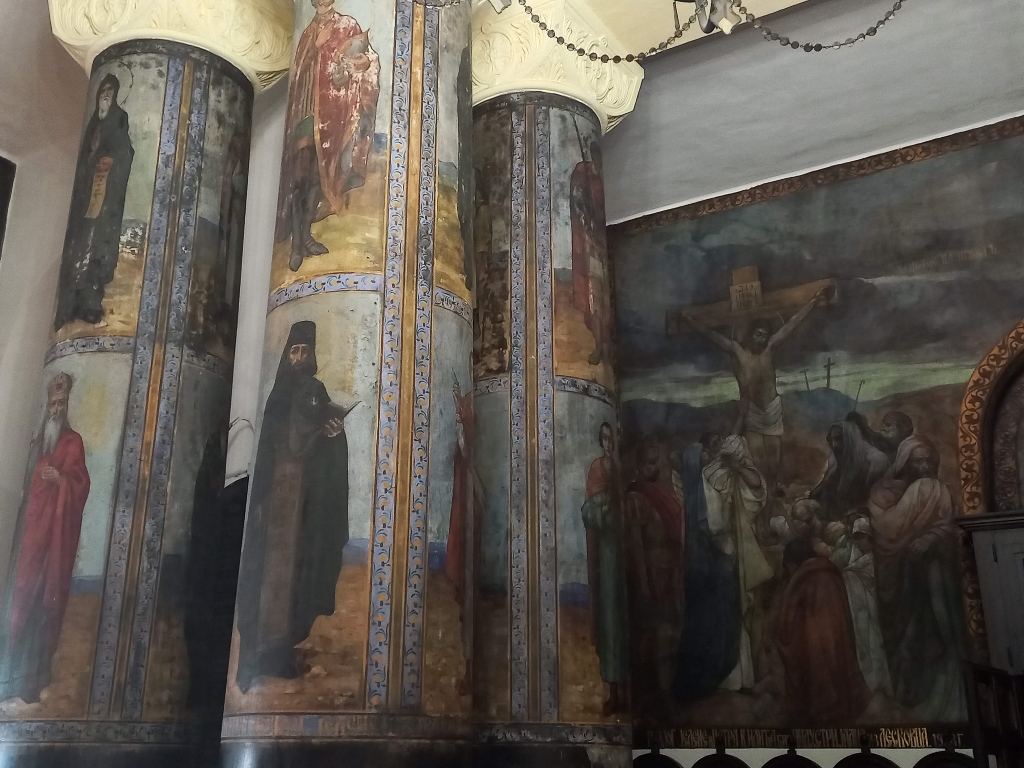 Cathedral of the Holy Trinity
Cathedral of the Holy Trinity
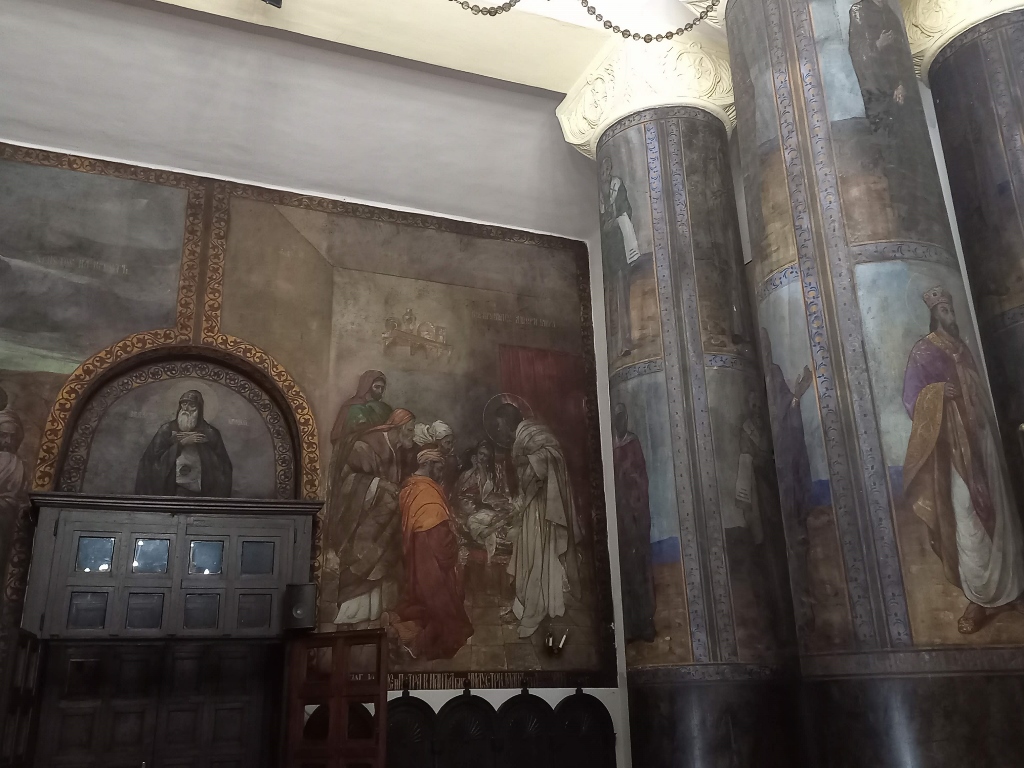 Cathedral of the Holy Trinity
Cathedral of the Holy Trinity
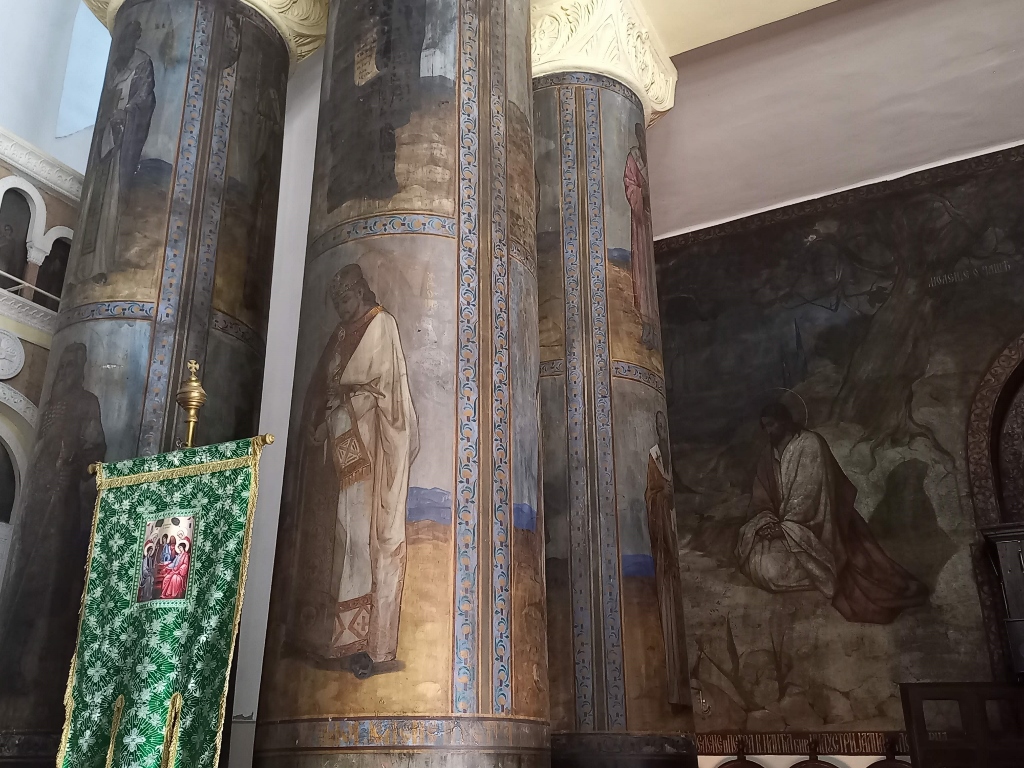 Cathedral of the Holy Trinity
Cathedral of the Holy Trinity
In the same churchyard as the Cathedral of the Holy Trinity, there is another church – the Old Church of the Nativity of the Theotokos, also known as the “Odžaklija” Church. There is also a bell tower located there. Incidentally, both of these churches, as cultural monuments, are classified as immovable cultural heritage.
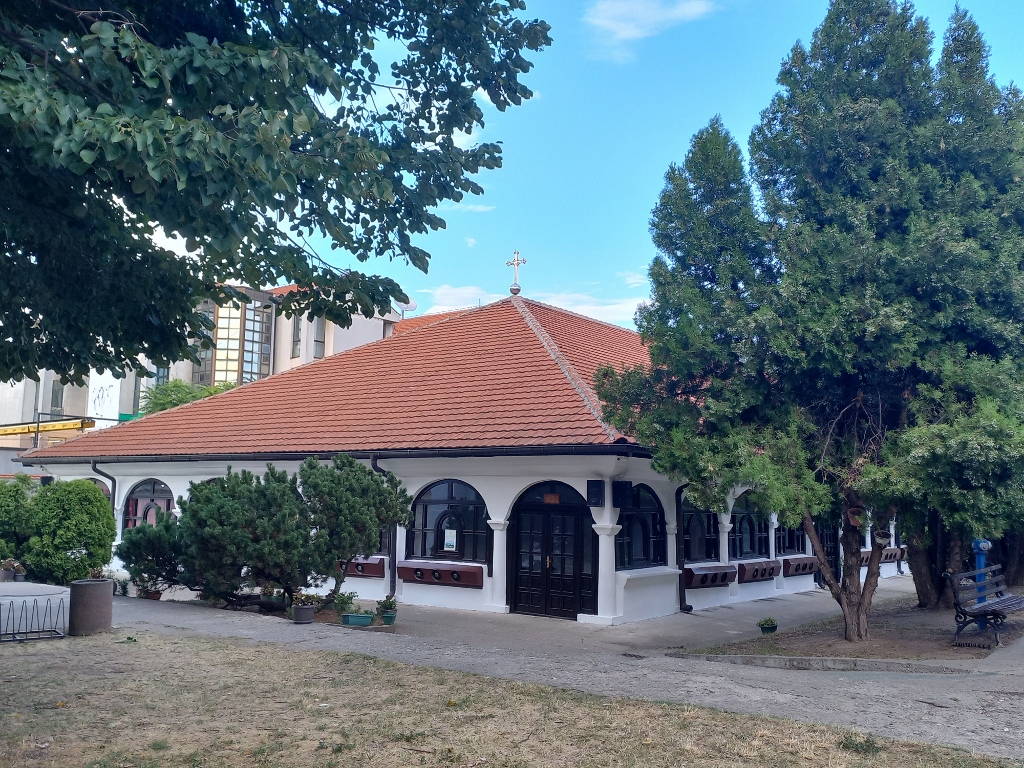 Odžaklija Church
Odžaklija Church
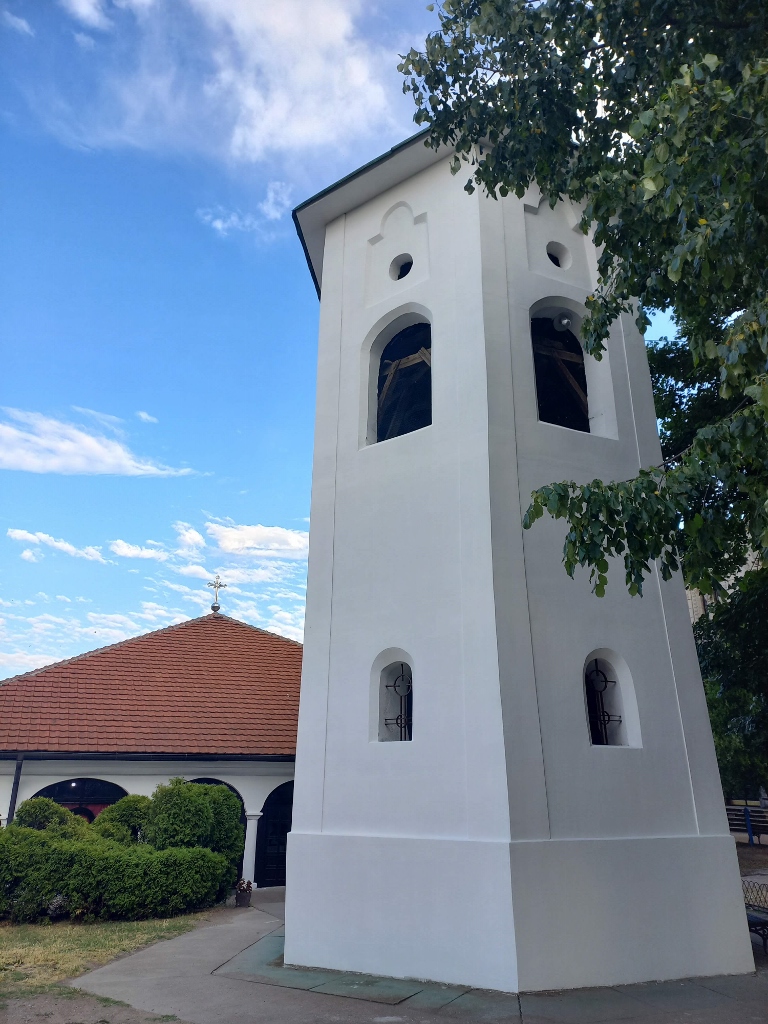 Odžaklija Church and the bell tower
Odžaklija Church and the bell tower
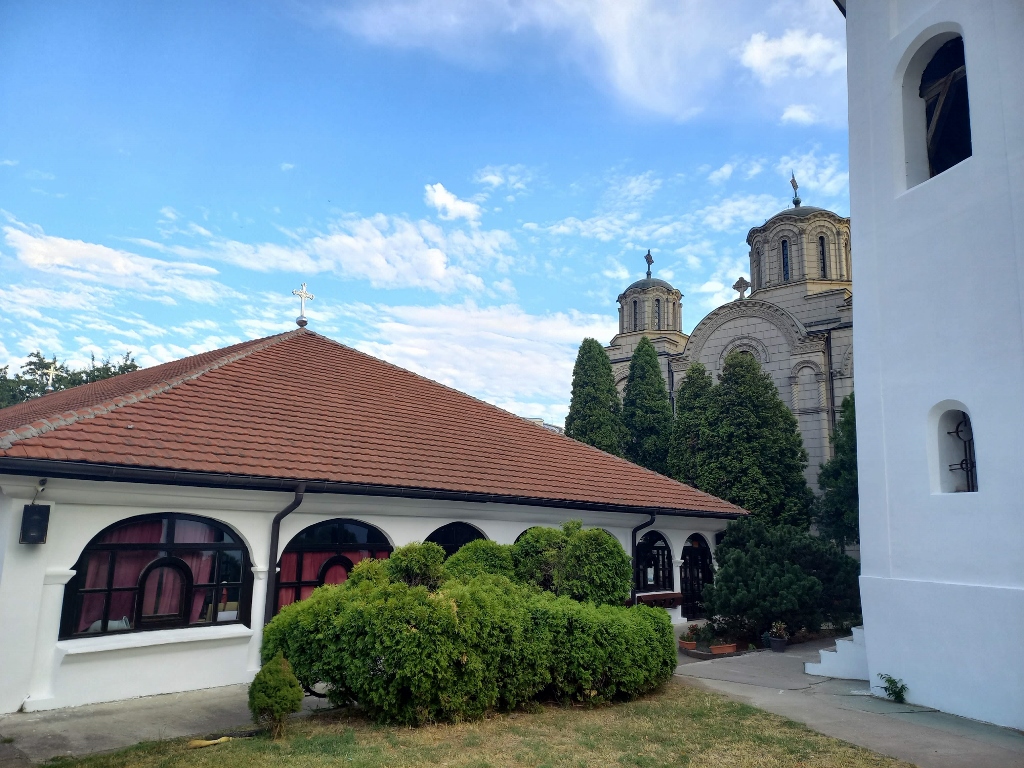 Odžaklija Church, Cathedral of the Holy Trinity and the bell tower
Odžaklija Church, Cathedral of the Holy Trinity and the bell tower
As I’ve said, the Odžaklija Church is dedicated to the Nativity of the Theotokos and it was built in 1803, during the time when this area was still under the rule of the Ottoman Empire.
There are a couple of legends surrounding the construction of this church, primarily due to its size. The church originally included a hearth and a chimney (odžak in Serbian, which is how it got its unofficial name), and this contributed to the creation of legends that highlight the resourcefulness of the Serbian people in outsmarting the Turkish rulers. In the case of this church, it was crucial that the Ottomans did not realise in time that a Christian place of worship was being built. The presence of a hearth and a chimney was meant to suggest that the building was a residential house.
Today, aside from its size and external appearance, the church is also surprising in that one has to descend into it – it appears to be partially sunken into the ground.
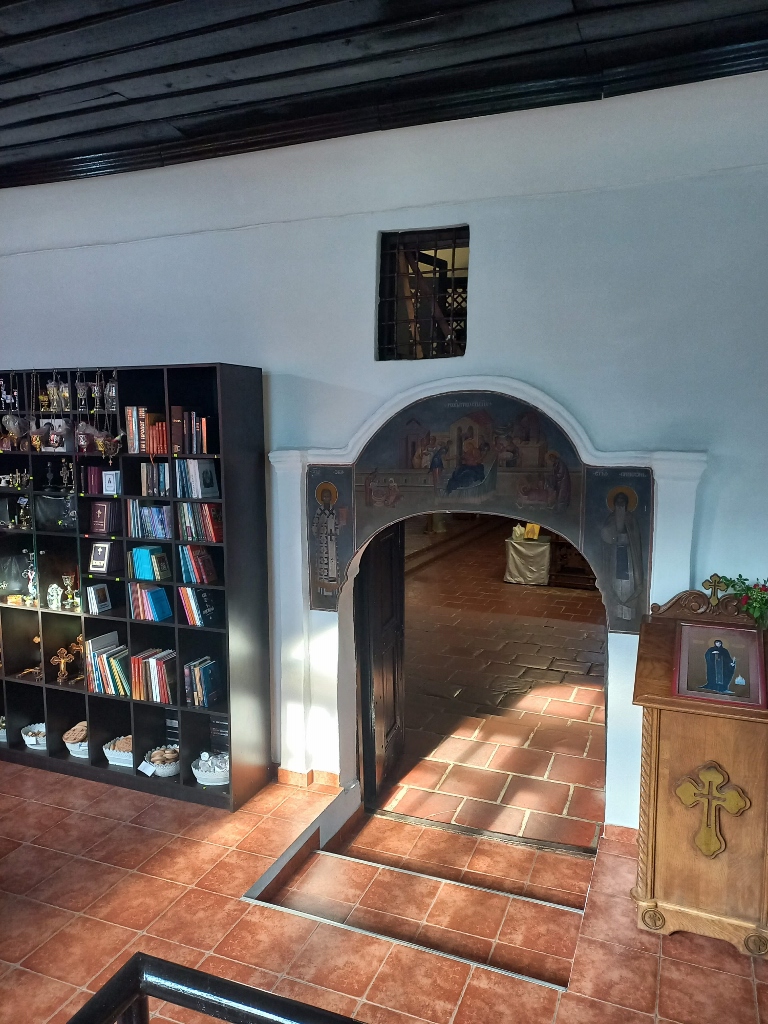 Odžaklija Church, a detail
Odžaklija Church, a detail
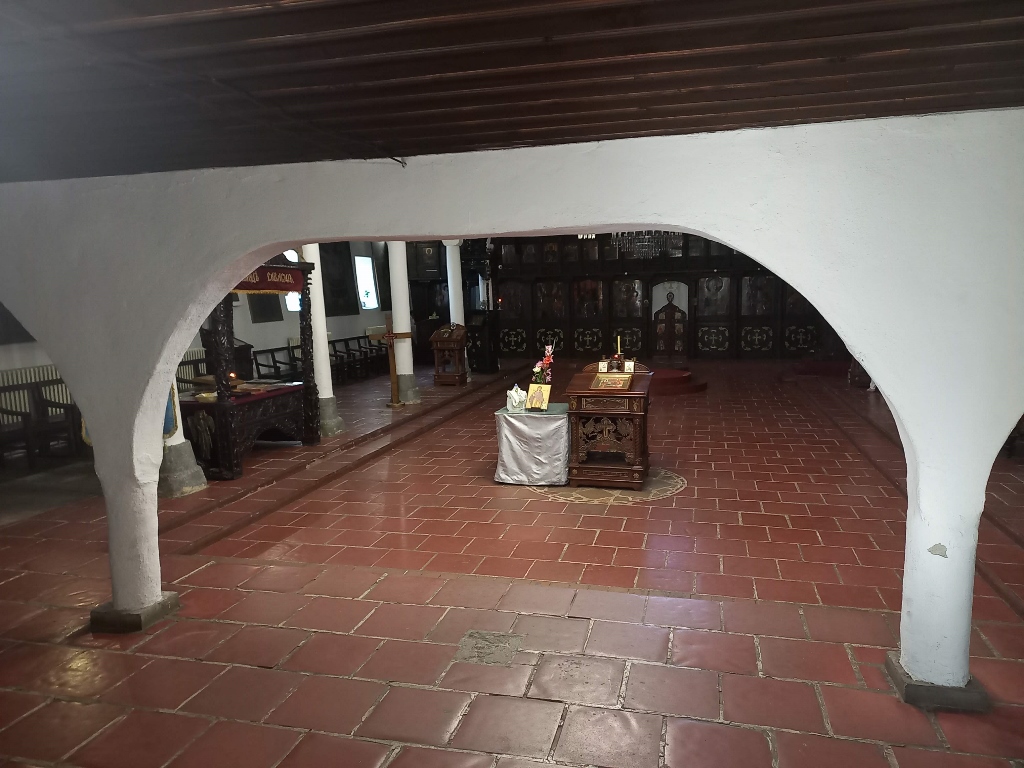 Odžaklija Church, a detail
Odžaklija Church, a detail
The church suffered damage several times during the first half of the 19th century and was restored in 1839. After the construction of the new church following World War I, the Odžaklija Church was simply left to the ravages of time. It was also damaged during both the German and the Allied bombings in World War II. In 1948, it was completely flooded, with the water level reaching about one metre. Although it was soon declared a cultural monument, no repairs were made, while in 1963 the roof structure collapsed entirely, including the chimney (though the hearth survived). Restoration finally began in the 1970s and it wasn't until 1992 that the church was reconsecrated.
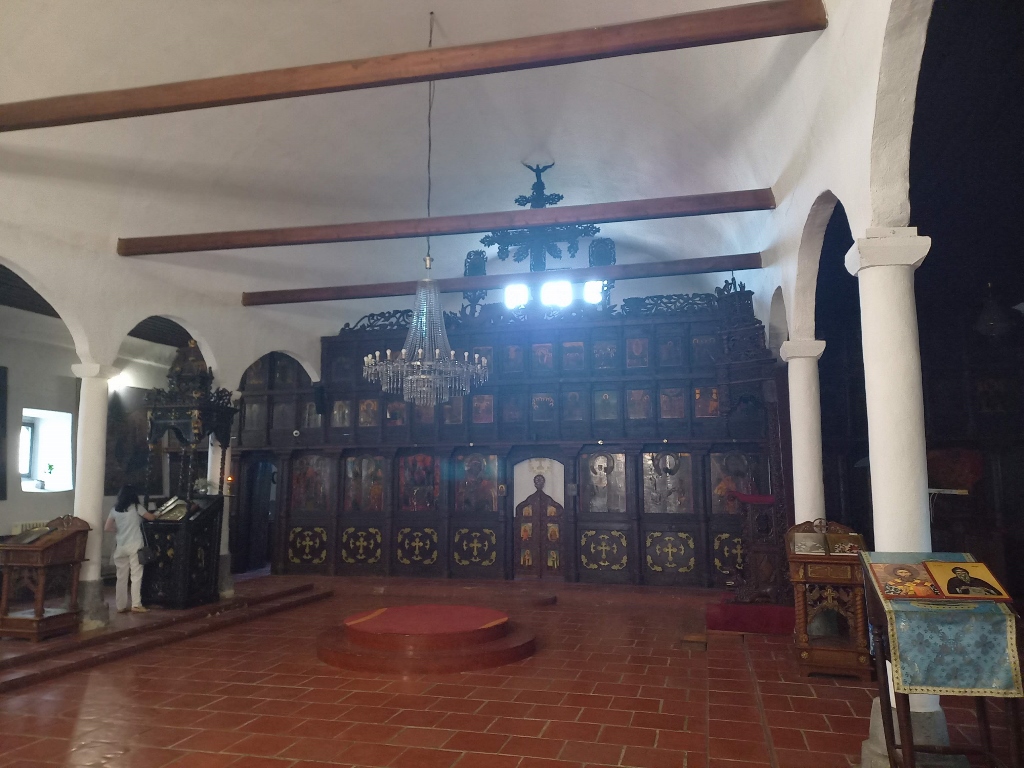 Odžaklija Church, a detail
Odžaklija Church, a detail
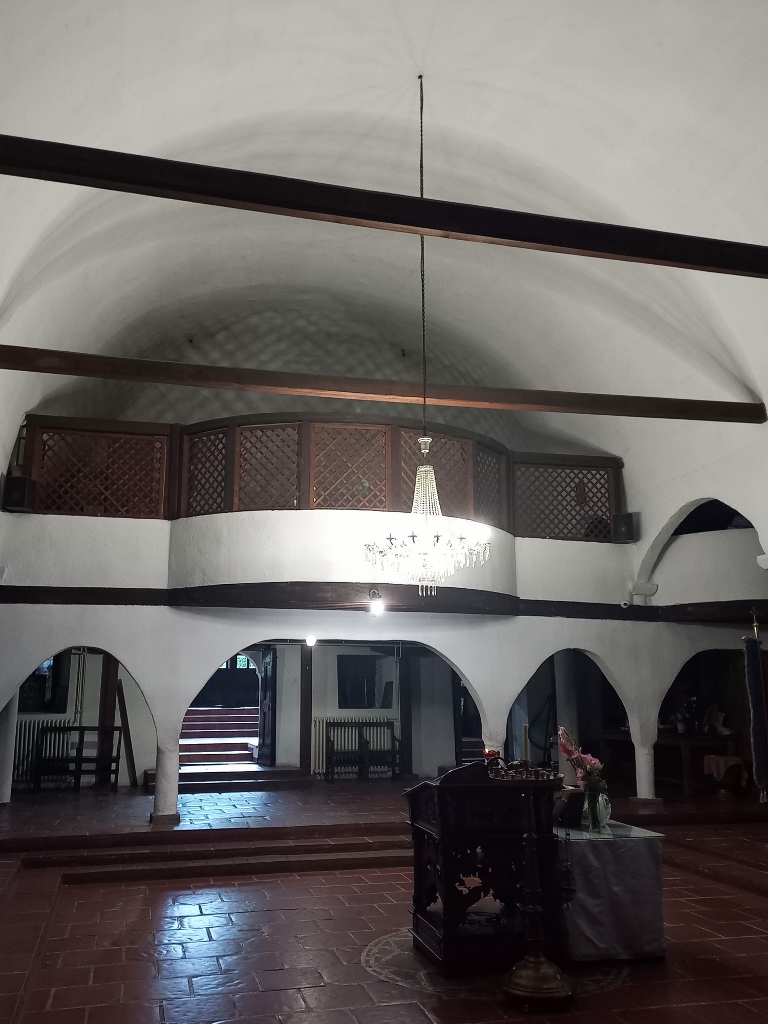 Odžaklija Church, a detail
Odžaklija Church, a detail
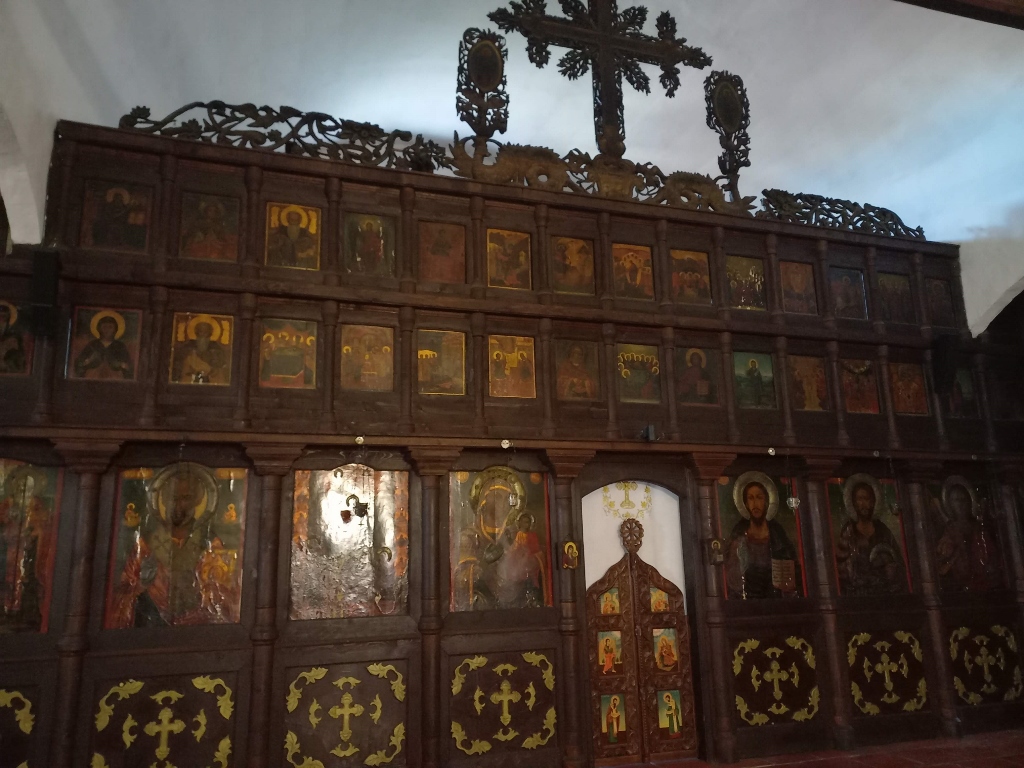 Odžaklija Church, a detail
Odžaklija Church, a detail
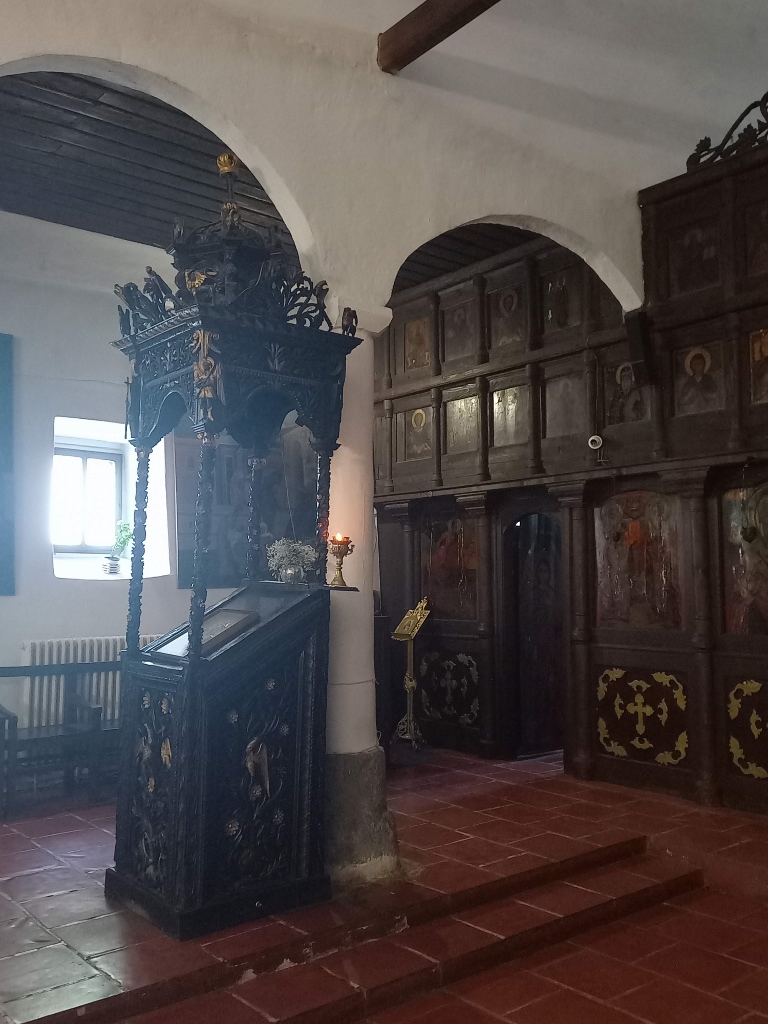 Odžaklija Church, a detail
Odžaklija Church, a detail
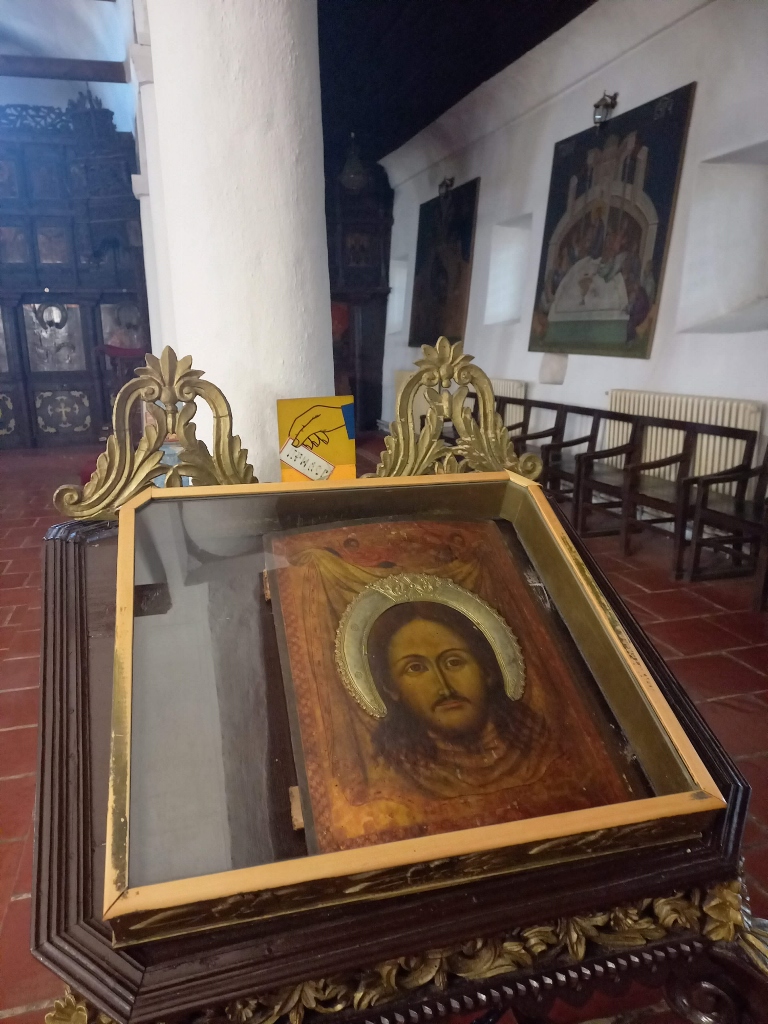 Odžaklija Church, a detail
Odžaklija Church, a detail
As for the hearth and chimney, despite the legend, it is assumed that they were originally built in order to heat the church space. Today, that function is served by radiators installed along the walls.
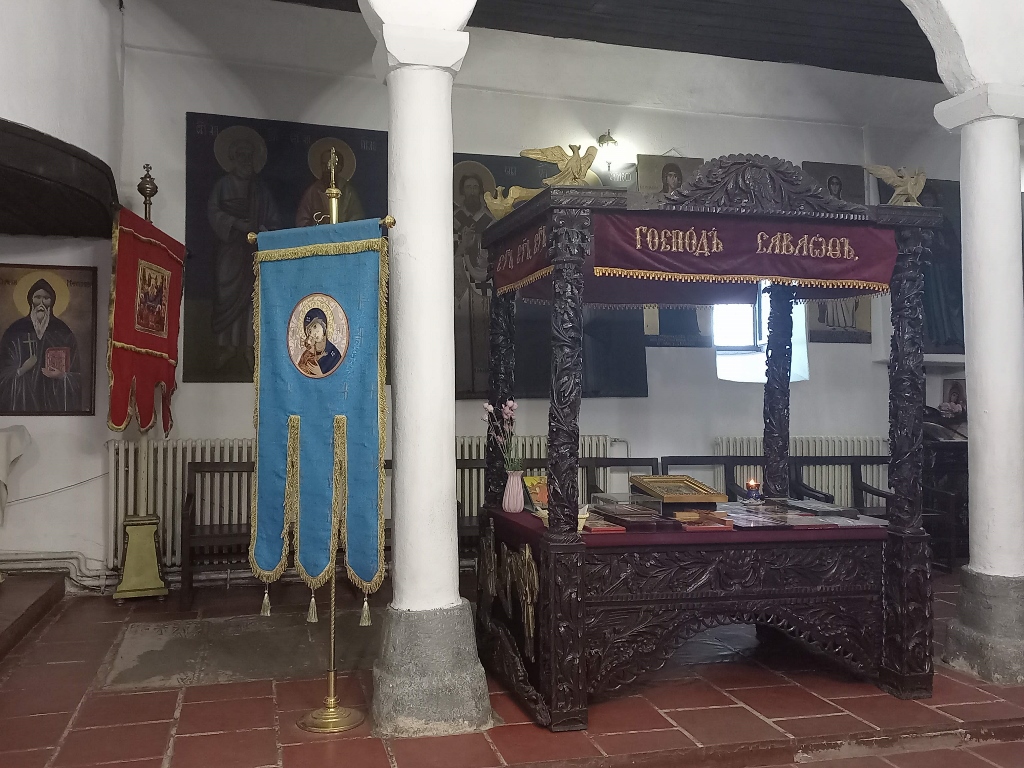 Odžaklija Church, a detail
Odžaklija Church, a detail
The churchyard shared by these two churches is located near the city’s main street, Bulevar Oslobođenja, which in this section is slightly widened by the sidewalks on both sides. At the time of my visit, these sidewalks were being renovated and newly paved. Likely because of this widened street area, this part of town is known as Široka čaršija (“Wide Bazaar Street”). During the Ottoman period, this area was actually the economic centre of the city.
Today, another cultural monument can be found in this part of Leskovac – the Kaloderma Palace.
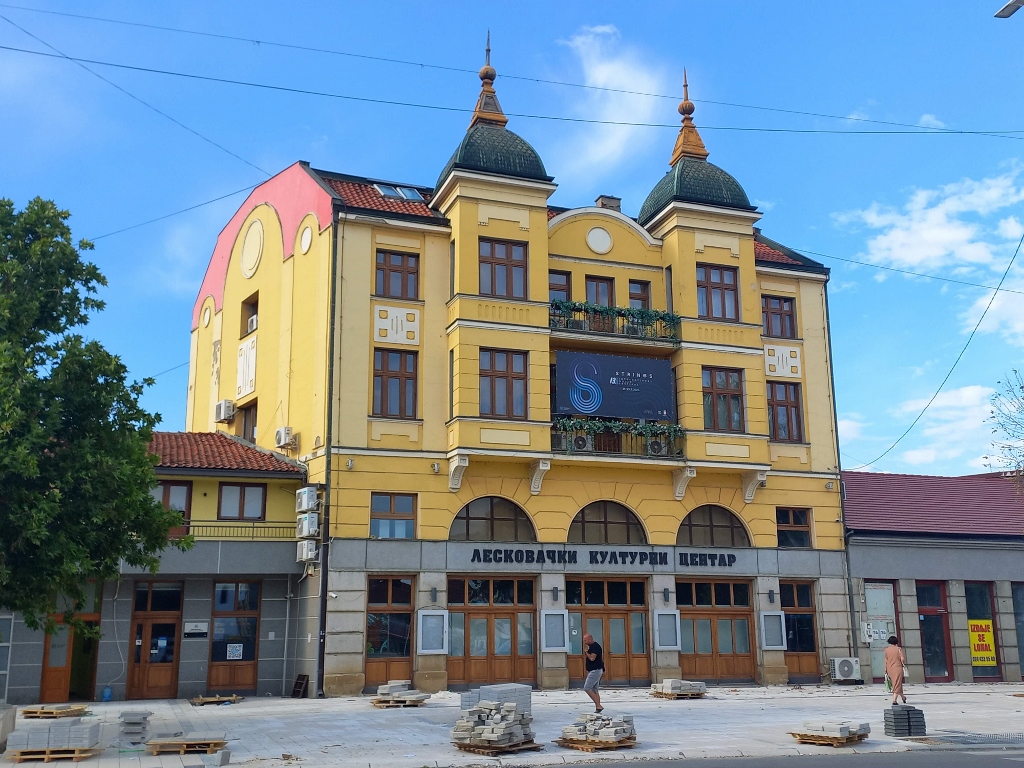 Kaloderma Palace
Kaloderma Palace
The name of this palace is particularly interesting. Besides the textile industry, Leskovac had a developed chemical industry between the two world wars, specifically in soap production, and later cosmetics and perfumes. It all started back in 1872 when a certain Jovan Vlajčić began producing soap. At first, it was quite rudimentary, but over time the business grew –his children studied the craft abroad and machines were imported from there. The factory faced major challenges during World War I, but production was later restored and further improved, and the factory was named “Kaloderma” (an abbreviated name). However, this name was already used in Germany for a soap known worldwide, leading to a legal dispute which the Vlajčić family lost. After World War II, the family’s entire property was confiscated, but this building remains as a reminder of that story.
As successful entrepreneurs, the Vlajčić family built the Kaloderma Palace, completed in 1927, which served as the administrative and production building of the soap factory. Today, it houses the Leskovac Cultural Centre.
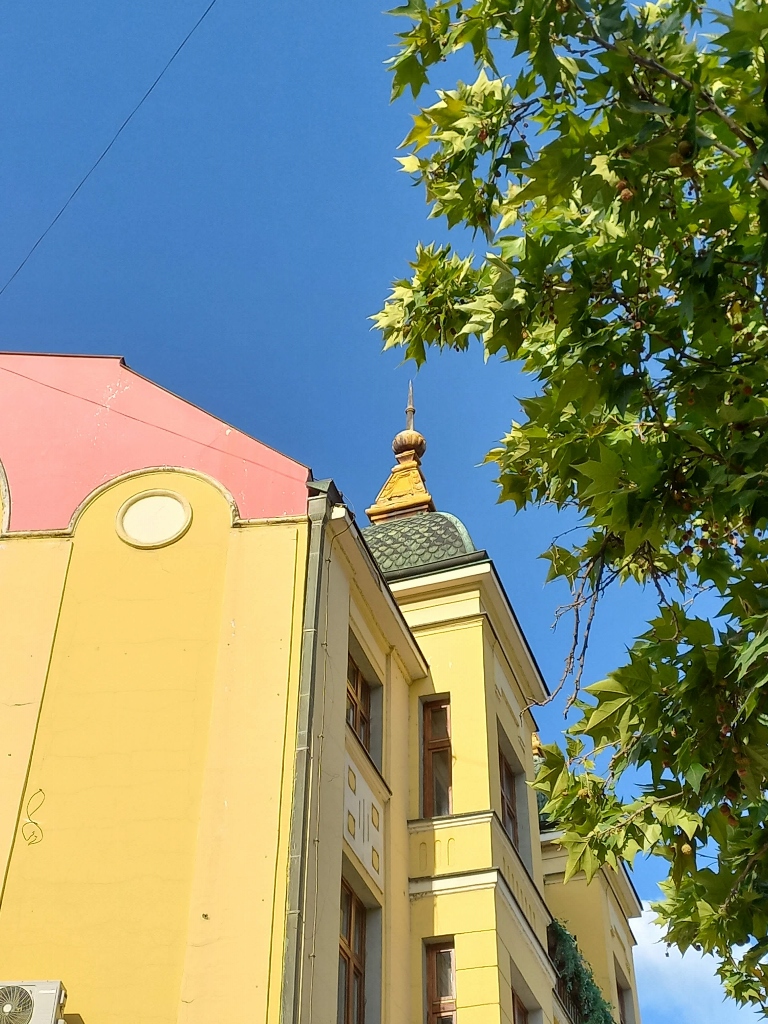 Kaloderma Palace, a detail
Kaloderma Palace, a detail
Just a few hundred metres further, on the opposite side of Bulevar Oslobođenja, there is another cultural monument – Tonkić’s Palace or the „Dubočica“ Hotel Building.
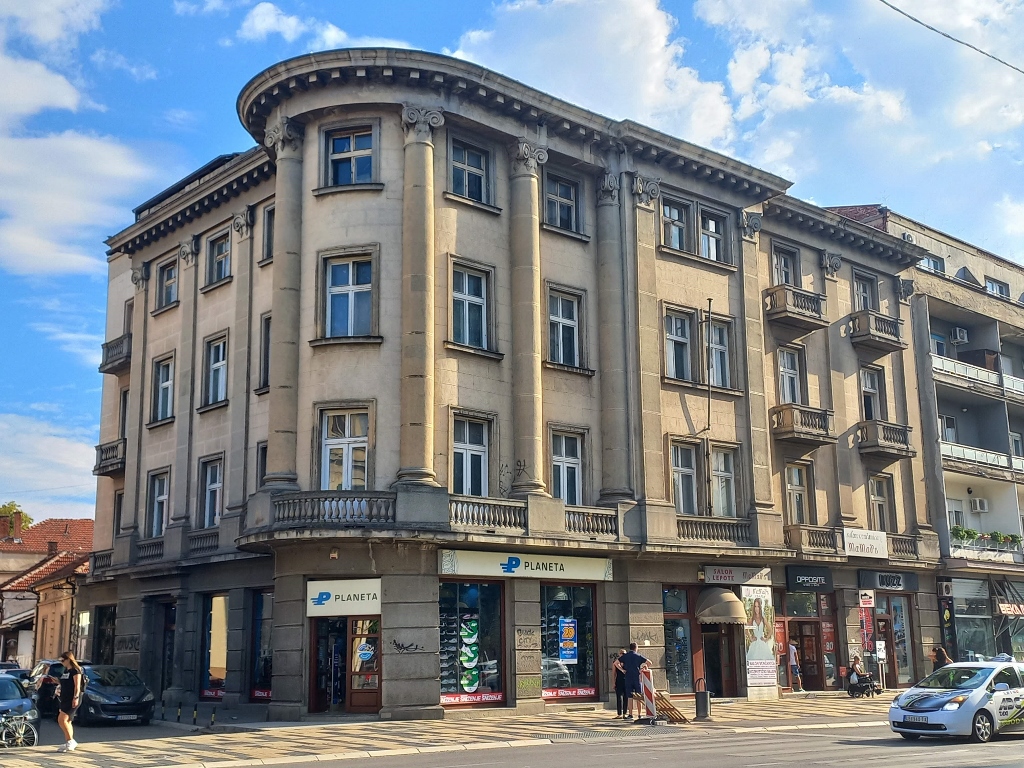 Tonkić’s Palace or the „Dubočica“ Hotel
Tonkić’s Palace or the „Dubočica“ Hotel
It is one of the most representative buildings in the city centre, built in 1937. The owner was another industrialist, Milan Popović-Tonkić and the building was erected on the site of an earlier family house. Since it had a ground floor and three upper floors, the building also featured a lift – a rather rare occurrence at the time, which added a certain prestige. The building’s charm is enhanced by its rounded corner segment, while the facade is further accentuated by attached columns and pilasters. The building was damaged during the Allied bombing in 1944 and after World War II it was restored. The upper floors were converted into rooms and a hotel was opened there (hence the name under which the building is listed as a cultural monument), while the ground floor housed hospitality businesses. The hotel closed in 2006, while the ground floor now contains various shops.
And to conclude this part, here is a photo that does not depict any cultural monument, but carries a very personal note – because these are, after all, my stories.
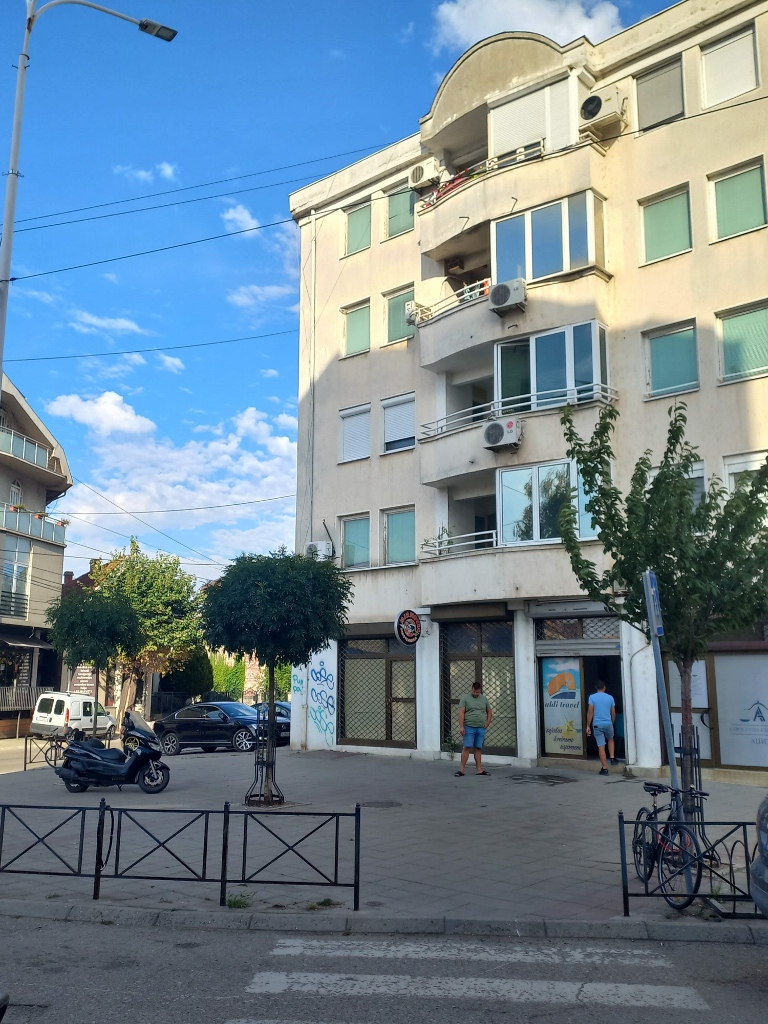 Leskovac, a detail
Leskovac, a detail
There used to be a drinking fountain on the square visible in the photo above, right in front of the newer building. As my father told me when we were walking here once, it was at that very fountain that my grandfather (my father’s father) drank water for the last time. After that, he fell ill, was taken to the hospital, but died there (the exact cause was never known). He was just a little over 30 years old and my father, the eldest of three children, was only six at the time. Because of this, a few years later my grandmother remarried and moved with her three children to Belgrade.